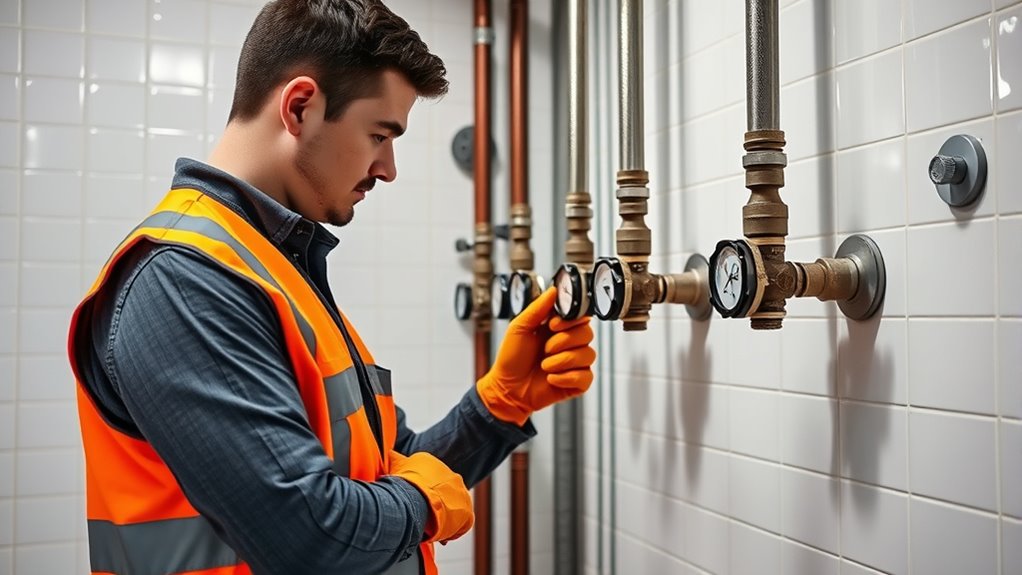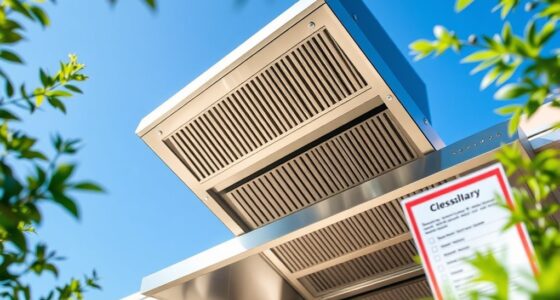To become confident in gas line planning and shutoffs, start by understanding the key components like pipes, pressure regulators, and valves. Design a clear layout that minimizes bends and ensures easy access to shutoff valves. Regularly inspect for leaks or damage, and know how to quickly turn off your main gas supply if needed. Staying safe involves proper installation, maintenance, and knowing the right steps—continue exploring to master these essential skills.
Key Takeaways
- Understand different pipe materials and their suitable applications for safety and durability.
- Plan a logical, accessible layout minimizing bends and long runs to ensure efficient gas flow.
- Install pressure regulators and leak detection methods to maintain safe, consistent gas pressure.
- Locate and label shutoff valves clearly for quick response during emergencies or maintenance.
- Conduct regular inspections and maintenance to identify leaks, corrosion, or damage promptly.
Understanding Gas Lines and Their Components
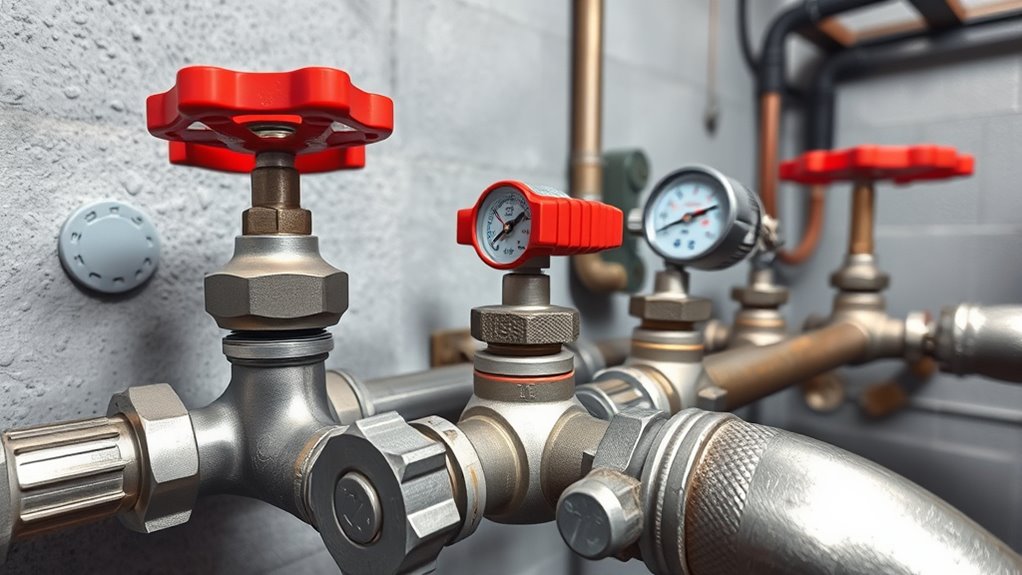
Understanding gas lines and their components is essential for safe installation, maintenance, and emergency response. You need to be familiar with different pipe materials, such as steel, copper, or flexible connectors, since each has specific uses and durability. Knowing how these materials withstand pressure and environmental factors helps prevent leaks or failures. Pressure regulation is another critical aspect; it ensures the gas flows at a safe, consistent level. Pressure regulators manage the gas pressure coming from the main supply to appliances, reducing the risk of over-pressurization. Recognizing how these components work together helps you identify potential issues early and maintain a safe gas system. Proper comprehension of pipe materials and pressure regulation is fundamental to keeping your gas line secure and functional. Understanding industry transformations can help you stay informed about advancements that enhance safety and efficiency.
Planning Your Gas Line Layout Safely and Effectively

Planning your gas line layout carefully is essential to guarantee safety, efficiency, and compliance with codes. Start by designing a clear, logical route that minimizes bends and long runs, reducing pressure loss. Proper regulator installation is crucial; place regulators where pressure needs to be controlled, and ensure they’re accessible for maintenance. Incorporate gas leak detection methods, such as installing gas detectors or using soap bubble tests during installation, to catch leaks early. Use appropriate materials and follow local codes to prevent future issues. Label all shutoff valves clearly for quick access. Consider future expansion needs, but prioritize safety and code adherence at every step. With careful planning, you’ll ensure a reliable, safe gas system that operates efficiently and can be maintained easily. Always review local building codes and permits to ensure your installation complies with regulations and safety standards.
Identifying Common Gas Line Issues and Troubleshooting
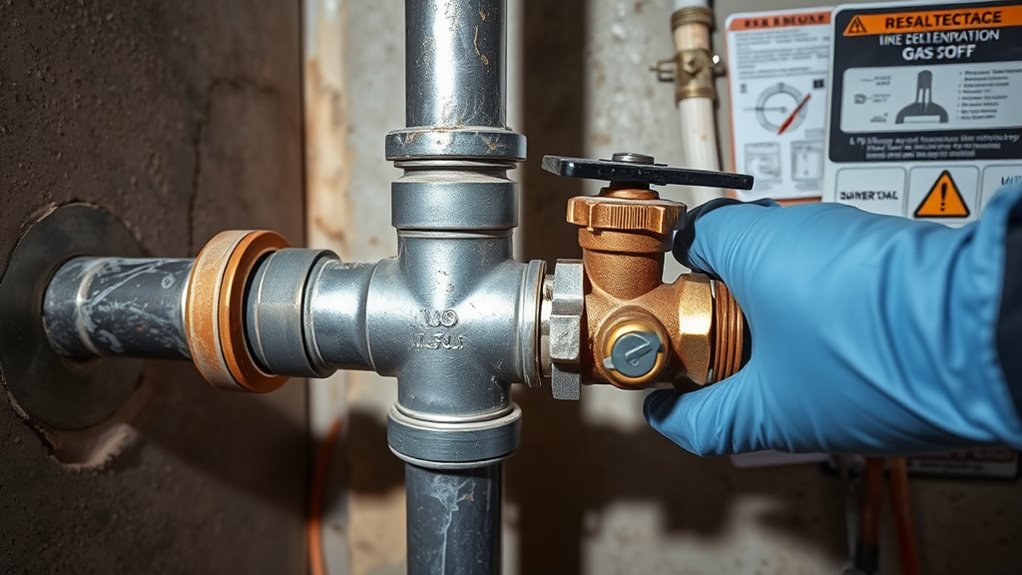
Gas line problems often manifest through noticeable issues like gas odors, pressure drops, or inconsistent appliance operation. If you smell gas, it’s *essential* to perform gas leak detection immediately—shut off the supply and call a professional. Corrosion prevention plays a key role in avoiding leaks; regularly inspect exposed pipes for rust or damage, especially in humid areas. Listen for hissing sounds or whistling, which can indicate leaks or loose fittings. Check for signs of corrosion or corrosion-related deterioration, like flaky rust or discoloration. Address issues promptly to prevent hazards. Regular maintenance and inspections help catch problems early. Remember, safety comes first—when in doubt, consult a licensed technician to troubleshoot and resolve gas line issues effectively. Ensuring proper installation and venting is vital for safety and efficiency in gas line systems.
Step-by-Step Guide to Shutting Off Your Gas Supply

When you notice signs of a gas leak or suspect a problem with your gas line, shutting off the supply quickly can prevent dangerous situations. To do this effectively, follow these emergency shutdown procedures. First, locate the main gas shutoff valve—usually near the gas meter. Turn the valve clockwise until it stops. Use gas leak detection techniques, like smelling for gas or listening for hissing sounds, to confirm the leak. Remember, acting swiftly minimizes risks. Here’s a quick reference:
| Step | Action | Safety Tip |
|---|---|---|
| 1 | Locate the shutoff valve | Ensure easy access |
| 2 | Turn valve clockwise | Do not use tools that could cause sparks |
| 3 | Evacuate and ventilate | Call emergency services if needed |
Always prioritize safety and consult professionals for repairs.
Tips for Maintaining Gas Line Safety and Preventing Emergencies
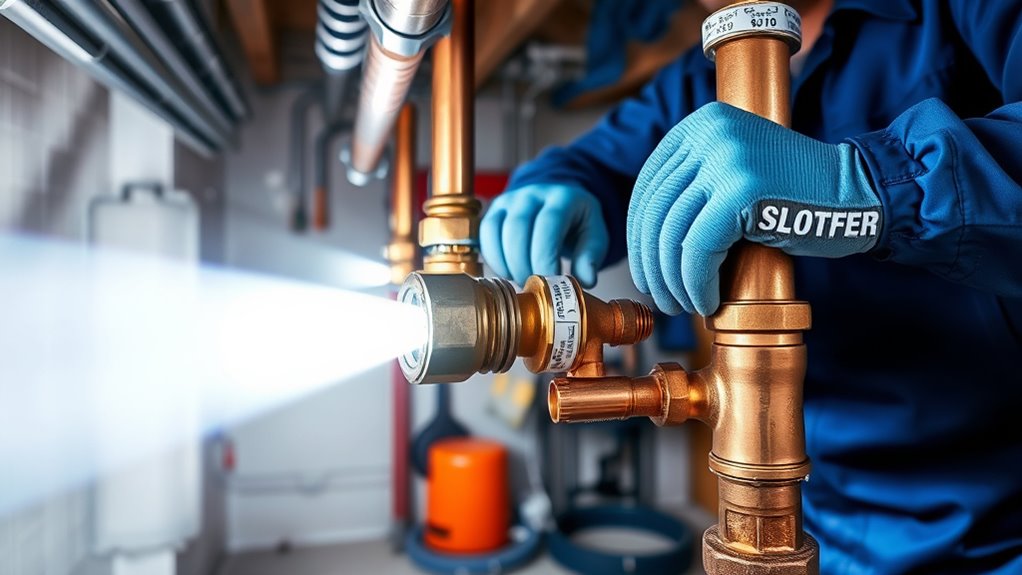
Regularly inspecting your gas lines and appliances is key to preventing emergencies. Follow local gas line regulations and adhere to recommended maintenance schedules to guarantee safety. Schedule routine inspections with a qualified technician to catch leaks, corrosion, or damage early. Keep an eye out for signs like hissing sounds, the smell of gas, or dead vegetation near the lines. Properly maintaining appliances and ensuring vents are clear reduces the risk of leaks and carbon monoxide buildup. Never ignore small issues; addressing them promptly can prevent costly repairs or dangerous situations. Staying proactive with regular inspections and following gas line regulations helps you maintain a safe environment and avoid emergencies before they happen. Regular maintenance and understanding firewood safety practices also contribute to overall safety in your home.
Frequently Asked Questions
How Often Should I Inspect My Gas Lines for Safety?
You should inspect your gas lines at least once a year to guarantee safety. Regular inspection frequency helps you catch leaks or damage early. Always follow safety precautions during inspections, like turning off the gas supply and wearing protective gear. If you notice any smell of gas, corrosion, or damage, immediately contact a professional. Staying proactive with these safety precautions protects your home and family from potential hazards.
What Are the Legal Requirements for Gas Line Installation?
You must follow local building codes and regulations for gas line installation to guarantee legal compliance. These rules specify proper installation procedures, including permits, inspections, and qualified professionals handling the work. Always check with your local authorities or a licensed plumber before starting installation. Adhering to these legal requirements not only keeps you compliant but also guarantees the safety and reliability of your gas system.
Can I Upgrade My Gas Line System Myself?
You shouldn’t attempt DIY upgrades on your gas line system, as it can be dangerous and may violate local codes. Always hire a licensed professional to handle upgrades, ensuring safety and compliance. After the work, a professional inspection is vital to confirm everything’s installed correctly and safely. This approach protects you from potential hazards and legal issues, giving you peace of mind knowing your gas system is secure.
How Do Weather Conditions Affect Gas Line Safety?
Did you know that extreme temperature fluctuations can cause gas lines to expand or contract up to 1/8 inch? Weather impact is significant; cold weather can make pipes brittle and prone to cracking, while heat causes expansion that might stress connections. These conditions increase the risk of leaks or ruptures. Always monitor weather forecasts and schedule inspections or shutoffs during severe weather to guarantee safety and prevent damage.
What Signs Indicate an Urgent Gas Leak Emergency?
If you notice gas leak symptoms like a rotten egg smell, hissing sounds, or visible gas or bubbles, you should treat it as an emergency. Evacuate immediately and avoid using electrical devices or open flames. Call emergency response right away. Acting quickly can prevent accidents, injuries, or explosions. Stay at a safe distance and wait for professionals to handle the situation. Your swift response is vital to safety.
Conclusion
Now that you’re a gas line guru, remember: ignoring leaks or mishandling shutoffs isn’t just risky—it’s a ticket to disaster. So go ahead, feel confident, but don’t get cocky. Treat your gas lines like fragile babies, not fire-breathing dragons. A little caution keeps you safe, and a little humor keeps you sane. After all, nothing says “I’ve got this” like knowing how to shut off your gas before things blow up—literally.
